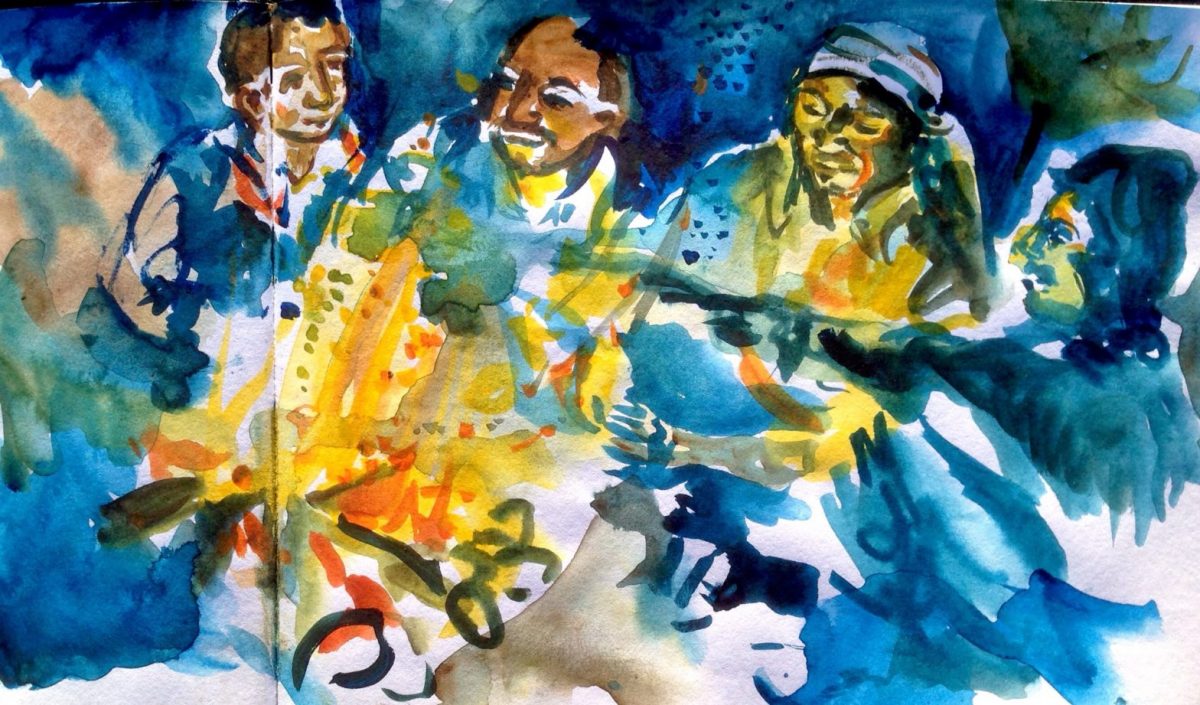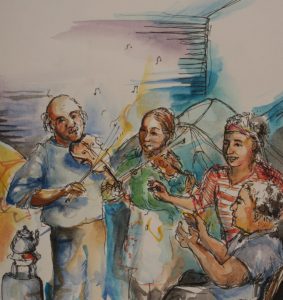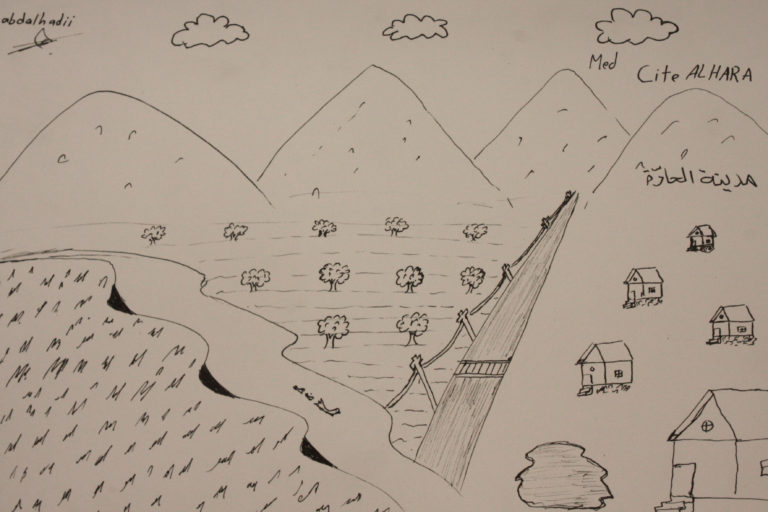Four Sketches
Texts: Harriet Paintin
Illustrations: Hannah Kirmes-Daly
______________________________________________________
1. Kobane
in Exile
He stood out from the dusty mass of people arriving and being put
onto buses; holding himself with pride, the face of a fighter. We watched him
from a distance as he paced up and down, like a lion in a cage, assessing this
impossible environment where refugees are processed, ticketed and given drab
sandwiches. He approached us, and picked up our darbouka drum. His slender fingers tapped out a rhythm as he sang, his voice heavy and melancholic. He stopped abruptly,
and complained that his fingers were too cold.
“You have the face of a guerrilla.” he pointed his long finger in Hannah’s face. “A guerrilla fighter.”.
Taken aback, we asked him where he came from. His eyes, hardened yet fiery, bore into us as
he hesitated before responding.
“Kobane.” He gave the two finger victory salute, and we nodded in
understanding. He stepped back into the crowd, pulling his red sports jacket
around him and glaring across the road, before turning on his heels and coming
back towards us, demanding what we know of Kobane, Rojava. We shared fragments of information about Kobane, a general awareness, and the tension in his body
relaxed somewhat, as if reassured by the fact that awareness of the long fight
which was his whole life had reached the shores of Europe before him.
He pointed again at Hannah’s dark hair, and eyebrows. “Kurdish women are the symbol of our
struggle. There is nobody stronger, not even men! In Iraq they have been
fighting Isis for more than a year, but our Kurdish women defeated them in a
month. For five years I was fighting, with them…” His voice took on a tone of sadness, reflected momentarily in
his strong face.
Hannah asked if she could draw him, and he was surprised. “It is my honour,’ he replied, and stood completely still as Hannah’s pen flew across the
paper, outlining his strong features, hollowed
and toughened from years of fighting and a long, perilous journey.
When the portrait was finished, a fleeting smile flashed across
his face and he wrote his name in the beautiful, flowing Kurdish script. Agrin, meaning
fire. He insisted that we tag him on Instagram,
writing his profile name in my notebook. He pointed at the name, and said, “She was a guerrilla, who fell during
the fighting …”

Figure 1: From Kobane
______________________________________________________
2. Memories from the village
Moria at night, the smoke hanging thick between
the olives trees, trees 100s of years old which have been all but stripped bare
as the branches are used as firewood. In
Being a refugee is an experience that
people are currently facing – it is not an identity. In these conditions, where
most conversations revolve around the horrendous journeys undertaken so far,
and apprehension for what lies ahead, it can be difficult to let the individual
shine through. But human interactions that take place around a fire at night,
faces illuminated only by the flickering firelight, jokes, laughter, missing
home, show us that we all carry
with us our personal stories of home, teenage crushes, embarrassments and in
these moments it becomes clear that by no means is the refugee experience all
that defines these people.
Sitting around a fire one particular
evening with a group of Pakistani men, Hannah painting in the near darkness,
their questions for information about the journey ahead quickly fell away into
laughter and shared moments of embarrassment.
“During my childhood I lived in a village.
Yeah, I used to play in the village, guli danda, football. no, not cricket – but guli danda is just like cricket. We used to have fun, me
and my friends.”
He sat in the middle of the group with his
headscarf bound around his head in exactly the same way you see in towns and
villages across South Asia. His eyes crinkled with laughter as he opened the
doors to his memories, the cheeky things he used to get up to in his youth.
Four others sat and watched with laughter in their eyes, feeding cardboard and
twigs into the fire.
“I had a girlfriend,” he went on, “and
I used to go to her house when she telephoned me. In our villages this sort of
thing isn’t allowed. Once when I was there her mum came home, and I had to hide
in another room. Her mum came in and looked around, then
she sat down. I had to walk past her to get out the house! So, I dressed in
women’s clothes, I put on the niqab, and went outside. When I
passed her mum I said ‘salaam alaikum’, she
replied ‘walaikum asalaam’,
and I walked on. Then another day, this happened again, and I did the same
thing.”
Laughter filled the atmosphere between us
and he grinned sheepishly before continuing.
“Sometimes I used to dress up in the niqab and go to the shop in the village, and ask for
Pepsi, sugar, other things. Then I’d say I didn’t have any money, I would write
my name and come back later,”
and he agreed, I wouldn’t go back later! Sometimes I’d walk around the village
wearing the niqab, go up to women and
say ‘hello hello’.”
At this point, one of the others spoke up: “Sat here talking with you people
like this, it’s refreshed us.
We’re not thinking about those we’ve left behind, the difficult journey, this
torment has left us for the moment. We’ll look back on this time fondly, inshallah, we’ll remember this.”

Figure 2: Memories from the village
______________________________________________________
3. Untold Stories of the Roma: Margarita
Podu Turcului weekly
market – a cacophony of horse carts, pigs being sold from the boot of a car and
homemade alcohol. Different Roma communities from across
Margarita was sitting on a small stool
surrounded by second hand shoes spread out on a plastic sheet; she stood out
amongst the other stallholders in her bright pleated skirt and colourful
headscarf. Her deeply lined face crinkled into a smile as she enthusiastically
gestured for us to sit down.
“Jesus didn’t make a distinction between
gypsies and non-gypsies, so why do people? We’re honest people, we want to work
and take care of our family. That’s it.” Her voice was
strong and impassioned, her gestures were so emotive. “There’s a lot of
discrimination when people don’t understand the gypsy culture. Where I come
from, in
She gestured towards her wares spread out
before her, shoes of all colours and sizes. “We have all of these things to sell and
we try to come to places like this where people don’t have much money, to try
and help them in this way. The people are very happy to buy good things, these
shoes come from
The Roma community are
often portrayed as needy or disadvantaged. Margarita strongly tried to assert
that she is neither of those things; rather, her resilient voice stressed the
help that she tries to bring to people within her own community. She waved as
we stood up to leave and, as we parted ways, she wished us “health, love and
power”.
28 September 2016

Figure 3: Margarita
______________________________________________________
4. Tracing the lines of hope and
remembrance: the Syrian camp, Calais
Following the
night in the Sudanese camp, we hoped to visit the Syrian camp which is made up
of fifteen men from a same village in

Figure 4: At the Syrian camp – Shaving
Hannah began
communicating in her broken Arabic and passing round pieces of paper,
encouraging the others to participate in the drawing while Ed and I took out
our violins and played a couple of tunes. People began dancing, shouting and
joking; the charged atmosphere swept us all up and carried us through. They
played Syrian music on their phones and we got up to dance with them. Hand in
hand we moved round and round in a circle, stumbling over the steps as they
leapt and stamped and shouted.

Figure 5: At the Syrian camp – Music
By sharing music,
art, and dance we were now feeling at ease, familiar. Hannah sat with a small
group, sketchbook on her lap, and impromptuly said, “tell me
about your hometown, your village, what does it look like? I can draw it for
you.”
They leaned in:
“There are the mountains, the river… the olive trees… and houses,
my house is here… yes, the mosque.”
They began
pointing out where their houses would be, showed us photos. They wrote their
names in Arabic above their houses. Gradually the village took shape on the paper
in front of us, and the story took a turn.
“Then there are the planes, flying over… and the police, with their
guns… the graveyard…”
“Here a dead
child, near my house. They died, the whole family… they were eating, in
Ramadan… all the family died. Seven people. My house…
BOOM! No house now. In the past, here was the house… Now, no house… bombs
broken.”
One man started
playing music on his phone, and sang. To us, to the image, but also to their
hometown, “the olive trees, the
olive trees…”
His eyes filled
up with tears, “I want to go
home, I want to return.”

Figure 6: Drawing the village [1]
But for many of
these men there is no home to return to. I sat talking to one man, who told me
that the difficulties and danger of life in
“Here there are problems. At home there are problems. In
We parted,
trying to not to show how shaken we were by what we had just experienced,
handshakes and “good luck!” and “see you in
As Hannah
finished tracing in the streets and school of their village, one man
tentatively reached for her sketch pad and pen and sat hunched over, drawing
out his own memory of his village. [Below]

Figure 7: Drawing the village [2]
The next morning
we passed by the Syrian camp again to give them some photocopies we had made of
the drawing. After yesterday’s highs and lows the atmosphere was slightly
subdued; frustration, a sense of desperation and the desire to leave hung in
the air. The man who had been shaving when we arrived the day before grabbed
Hannah’s sketchbook and started rifling through it. He stopped on a sketch and
pointed at one of the men.
“This morning, he went under a lorry and made it to
_______________
See also the
video version of this story:
Mapping the lines
of flight and hope :: https://youtu.be/DUAkP5nz4_c